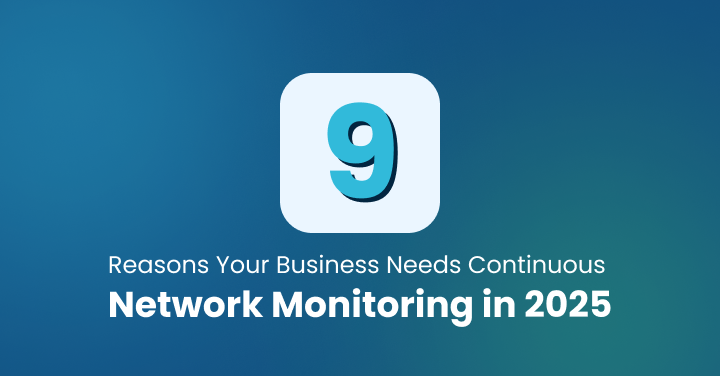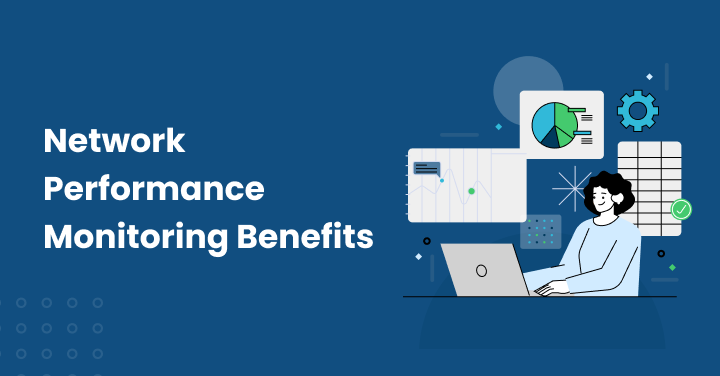Network has become the silent foundation of business success. Every click, transaction, and customer interaction relies on the performance and reliability of the underlying IT infrastructure.
From cloud applications to edge devices and distributed data centers, modern enterprises depend on networks that are always on, always fast, and always secure.
Yet maintaining this reliability has never been more challenging. As organizations expand across hybrid and multi-cloud environments, IT complexity skyrockets.
Networks now span thousands of interconnected components that must operate flawlessly together. Any disruption can affect service delivery, breach SLAs, and damage customer trust.
This is where Enterprise Network Monitoring (ENM) plays a pivotal role. It is not just a diagnostic utility but a strategic framework that ensures networks remain resilient, compliant, and high performing.
ENM provides deep, real-time visibility into every layer of network infrastructure, enabling organizations to uphold service level commitments and sustain uninterrupted operations even in the face of unexpected events.
This blog explores how Enterprise Network Monitoring supports SLA compliance and business continuity, and why it has become indispensable for enterprises navigating today’s complex digital ecosystems.
Understanding the Foundations: ENM, SLA, and Business Continuity
Before exploring how ENM drives operational reliability, it is essential to clarify what each concept represents and how they interconnect.
What is Enterprise Network Monitoring (ENM)?
Enterprise Network Monitoring is the systematic process of observing, analyzing, and managing all network components to ensure seamless connectivity and performance.
This includes routers, switches, servers, endpoints, cloud workloads, and virtualized systems. By continuously collecting and analyzing network data, ENM helps IT teams identify faults, track performance trends, and predict potential failures before they disrupt service.
Modern ENM platforms use advanced analytics, machine learning, and automation to convert raw performance metrics into actionable insights.
They empower IT leaders with the intelligence needed to optimize network performance, strengthen security, and maintain compliance with service expectations.
What are Service Level Agreements (SLAs)?
A Service Level Agreement is a contractual commitment between a provider and its customers that defines measurable performance standards.
These may include network uptime, latency thresholds, response times, and resolution targets. SLAs act as a formal promise of service reliability and performance consistency.
Failure to meet SLAs can have severe implications. Financial penalties, reputation loss, and diminished client confidence often follow repeated violations.
Hence, ensuring SLA compliance is not merely a technical objective but a strategic business requirement tied to trust and profitability.
What is Business Continuity (BC)?
Business Continuity refers to an organization’s ability to sustain its essential functions during and after a disruption.
Whether caused by equipment failure, human error, cyber incidents, or natural disasters, disruptions can cripple operations. A sound business continuity plan ensures that critical services remain available, minimizing downtime and operational losses.
How ENM Connects SLA Compliance and Business Continuity
Enterprise Network Monitoring acts as the bridge between SLA adherence and business resilience.
By offering real-time visibility into network performance and enabling proactive management, ENM allows organizations to identify risks early and maintain stability under pressure.
It not only prevents SLA breaches but also strengthens the organization’s ability to recover quickly when disruptions occur.
Enterprise Network Monitoring as the Enforcer of SLA Compliance
SLAs represent a promise of reliability, and fulfilling them requires precision, consistency, and accountability.
Enterprise Network Monitoring provides the mechanisms to measure, monitor, and maintain performance within contractual boundaries. It transforms SLA management from a reactive process into a proactive discipline.
1. Tracking Metrics and Establishing Baselines
At the core of SLA enforcement lies the continuous measurement of performance indicators that define network health. ENM tracks metrics such as:
- Latency: The time it takes for data packets to traverse the network.
- Packet Loss: The percentage of data packets that fail to reach their destination.
- Jitter: The variation in packet delivery times, which affects real-time applications like voice or video.
- Uptime: The percentage of time the network remains operational and available.
By analyzing historical data, ENM establishes baseline performance patterns. These baselines represent the “normal” state of network operations and act as benchmarks for identifying anomalies.
When performance deviates from these baselines, alerts can be triggered, allowing engineers to take corrective action before users experience any impact.
For example, if an enterprise network typically maintains a 15-millisecond latency, and ENM detects consistent spikes to 25 milliseconds, it can immediately alert administrators to investigate potential congestion or routing issues.
This level of visibility ensures problems are caught early, preventing SLA violations.
2. Proactive Alerting and Threshold Management
Legacy monitoring systems were largely reactive, alerting teams after an incident occurred. Modern ENM tools adopt a proactive model.
They use intelligent alerting and threshold management to warn teams before performance drops below acceptable SLA levels.
Alerts can be configured to trigger when metrics approach 80–90% of their threshold values, enabling preemptive remediation.
Advanced systems use predictive analytics to forecast potential SLA breaches based on traffic patterns, resource consumption, or seasonal workload spikes.
This proactive mechanism not only prevents downtime but also demonstrates operational diligence.
Historical alert data serves as a compliance record during SLA audits, proving that the organization monitored and acted on issues before they escalated.
3. Reporting, Auditing, and Evidence Generation
Transparent reporting is a cornerstone of SLA compliance. ENM platforms generate automated reports that verify whether performance objectives have been consistently met.
These reports include uptime statistics, latency averages, and incident resolution timelines.
For enterprises guaranteeing 99.999 percent availability, ENM provides verifiable evidence that contractual obligations are being upheld. In cases where disputes arise, this data becomes irrefutable proof of compliance.
Moreover, these insights help organizations continuously refine their performance strategies by identifying recurring bottlenecks and optimizing configurations.
In essence, Enterprise Network Monitoring does more than enforce SLA adherence. It validates it through real-time data, historical evidence, and actionable intelligence, ensuring that promises made to customers are promises kept.
Enterprise Network Monitoring as the Foundation for Business Continuity
While SLA compliance ensures performance under normal conditions, business continuity ensures survival under adverse circumstances. Together, they form two sides of operational resilience. ENM is the common foundation that supports both.
1. Fault Detection and Root Cause Analysis (RCA)
Every second of downtime costs money and credibility. ENM minimizes both by detecting and isolating faults in real time. When an issue arises, it rapidly identifies whether the cause lies in hardware, configuration, or security.
By automating root cause analysis, ENM drastically reduces the Mean Time to Detect (MTTD) and Mean Time to Resolve (MTTR).
For example, a monitoring platform might detect a sudden spike in packet loss, trace it to a misconfigured switch port, and guide the operations team toward a fix — all within minutes.
The faster faults are detected and resolved, the shorter the disruption, ensuring that essential business functions continue uninterrupted.
2. Capacity and Resource Planning
Business continuity also depends on anticipating future demand. ENM platforms analyze long-term performance trends to predict when infrastructure resources will reach saturation.
By examining bandwidth utilization, link throughput, and server loads, ENM helps IT leaders plan capacity upgrades before congestion or performance degradation occurs.
Consider a telecommunications company that notices rising traffic on a regional backbone. ENM trend data might reveal that utilization will reach 80 percent within two months, prompting early procurement of additional bandwidth.
This foresight prevents outages caused by overloaded circuits and ensures consistent performance even during peak loads.
3. Validating Disaster Recovery (DR) Readiness
Disaster recovery plans are only effective if validated regularly. ENM continuously monitors backup links, redundant systems, and failover mechanisms to ensure they are synchronized and operational.
During DR drills or real-world failovers, ENM validates network performance in both primary and secondary systems, confirming that switchovers occur seamlessly without data loss.
After recovery, ENM verifies that the primary systems resume normal operations and that no lingering faults persist.
This constant validation guarantees genuine readiness, transforming disaster recovery from a checklist exercise into a proven resilience mechanism.
Synergistic Benefits and Advanced Practices in ENM
Modern enterprise networks cannot afford isolated monitoring. They require integrated visibility across all IT layers.
ENM delivers that holistic perspective while bridging the gap between performance, security, and automation.
1. Centralized Visibility: The “Single Pane of Glass”
In large enterprises, multiple monitoring tools often create fragmented visibility. ENM solves this by offering a unified platform that consolidates network, application, and infrastructure monitoring into a single interface.
This unified visibility allows IT teams to analyze cross-domain performance issues quickly. Collaboration between network operations, security operations, and application development teams becomes seamless, reducing incident resolution time and eliminating finger-pointing.
With one source of truth, decision-making accelerates, and accountability improves across the organization.
2. Security and Performance Convergence
Performance and security are deeply intertwined. A network slowdown could just as easily stem from a DDoS attack as from bandwidth congestion. ENM tools that integrate flow analytics such as NetFlow or sFlow can detect both simultaneously.
By analyzing traffic patterns, ENM identifies anomalies like unexpected traffic surges, unauthorized data flows, or suspicious IP activity. It alerts security teams while also quantifying performance impact.
This dual visibility ensures that security threats are addressed without compromising performance or compliance.
Maintaining network health therefore directly contributes to data protection and service reliability, aligning IT operations with cybersecurity objectives.
3. Automation and Orchestration
Automation is the defining capability of next-generation ENM. By integrating with IT Service Management (ITSM) and orchestration tools, ENM platforms can automatically trigger remediation workflows.
For example, when a monitoring system detects a downed service, it can automatically restart the process or isolate a problematic port.
In more advanced cases, ENM data feeds into configuration management databases to adjust routing paths, apply patches, or scale resources dynamically.
This automation reduces manual intervention, minimizes human error, and ensures faster response times. The result is a self-optimizing network capable of sustaining SLA compliance and business continuity with minimal human oversight.
The Broader Business Impact of Effective ENM
Beyond technical performance, Enterprise Network Monitoring delivers quantifiable business value. It strengthens customer relationships, reduces financial risk, and provides a strategic advantage in competitive industries.
Building Customer Trust
Reliability builds credibility. When customers experience consistent performance, their confidence in the brand grows. ENM helps enterprises prove reliability through transparent data, reinforcing customer satisfaction and loyalty.
Avoiding Financial Penalties
SLA violations can lead to expensive penalties. With proactive monitoring and automated reporting, ENM minimizes such risks.
Even in the rare event of a breach, detailed performance data provides transparency, often protecting the provider’s reputation and reducing financial liability.
Gaining Competitive Advantage
In sectors where speed and reliability define market leadership, such as banking, e-commerce, and telecommunications, ENM offers a strategic edge.
Organizations equipped with predictive monitoring can deliver superior service levels, respond faster to incidents, and outperform competitors bound by legacy monitoring tools.
Looking Ahead: The Future of ENM with AI and Machine Learning
The evolution of Enterprise Network Monitoring is accelerating with artificial intelligence. Machine learning algorithms now enable predictive observability — the ability to anticipate problems before they occur.
AI-powered ENM systems can recognize subtle deviations from baseline behavior, predict equipment failures, and recommend preemptive actions.
They can even perform automated corrections, effectively creating self-healing networks.
In the near future, these intelligent systems will not just monitor network health; they will optimize it autonomously, ensuring continuous compliance and resilience without constant human intervention.
This shift from reactive to predictive and autonomous monitoring marks a major leap in how enterprises will manage performance and continuity.
Conclusion
In an era where digital connectivity defines competitiveness, Enterprise Network Monitoring has become indispensable. It is both a compliance enforcer and a resilience enabler.
By continuously measuring key performance metrics, triggering early alerts, and automating responses, ENM ensures organizations meet their SLA commitments with confidence.
At the same time, its predictive insights, fault detection, and capacity planning capabilities ensure that critical operations continue seamlessly even during disruptions.
A unified ENM strategy transforms network monitoring into a business enabler. It reduces risk exposure, enhances customer trust, and strengthens operational reliability.
As AI and automation continue to mature, enterprises that invest in intelligent ENM today will lead the way in delivering uninterrupted, high-performance digital experiences tomorrow.
FAQs
SLA compliance focuses on maintaining agreed performance metrics under normal operating conditions, while business continuity ensures service stability during disruptions. ENM supports both by providing real-time visibility, predictive analytics, and automated remediation.
ENM identifies performance anomalies early, isolates affected network segments, and initiates automated containment or rerouting actions. This reduces downtime, protects data integrity, and limits the scope of the breach.
AI and machine learning enhance ENM by detecting complex patterns, predicting failures, and automating responses. This creates intelligent, self-learning systems that deliver proactive maintenance and ensure near-perfect uptime.







